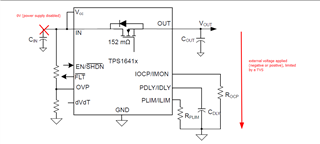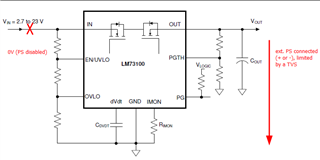Other Parts Discussed in Thread: TPS2662, TPS2660, TPS25961
Dear all,
I would like to confirm my understanding of Abs. max ratings and behaviour of two components:
1) TPS16412
2) LM731000
The situation is as follows,
TPS16412

- pins VCC and IN floating (connected to GND via ~1M resistance)
- pin GND connected to system GND
- positive or negative voltage at OUT pin
Q1: The part will withstand w/o damage -1V < Voltage @ OUT < 42V (section 7.1 of the DS) even when VCC and IN floating, correct?
Q2: The body diode of the internal FET will, however, conduct if VOUT is positive and thus the voltage at IN pin will be (VOUT - "body diode drop"), correct?
Q3: Reverse current under these circumstances will sort of 'back-power the device', correct?
LM731000

- IN floating
- pin GND connected to system GND
- positive or negative voltage at OUT
Q4: The part will withstand w/o damage -0.3V < Voltage @ OUT < 21V (section 6.1 of the DS, full temp range), correct?
Q5: Due to the internal B2B mosfets, the voltage @ OUT won't be present at IN pin, correct?
The motivation here is that these devices should protect both the power supply and the load. The power supply needs to be turned off to conserve power and thus the IN pins will not always be powered up. At the same time there is a chance that a user will connect a power supply (at the load side) instead of the load and thus a non-zero voltage might appear at the OUT pins.
Feel free to make a suggestion about a part with current limit, auto-retry and reverse current blocking when not powered up (VIN 3V-15V, Ilim 0.15-0.2 A, ideally internal FETs but external possible too).
Thank you

